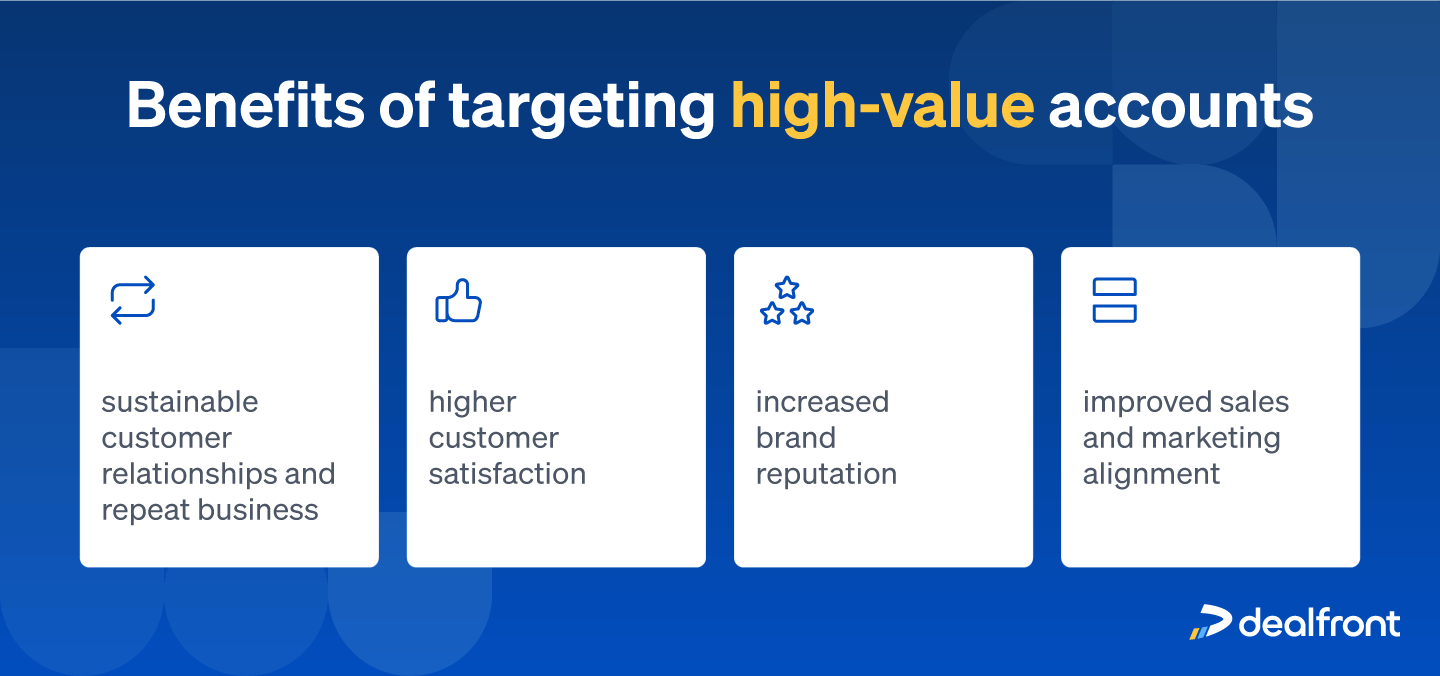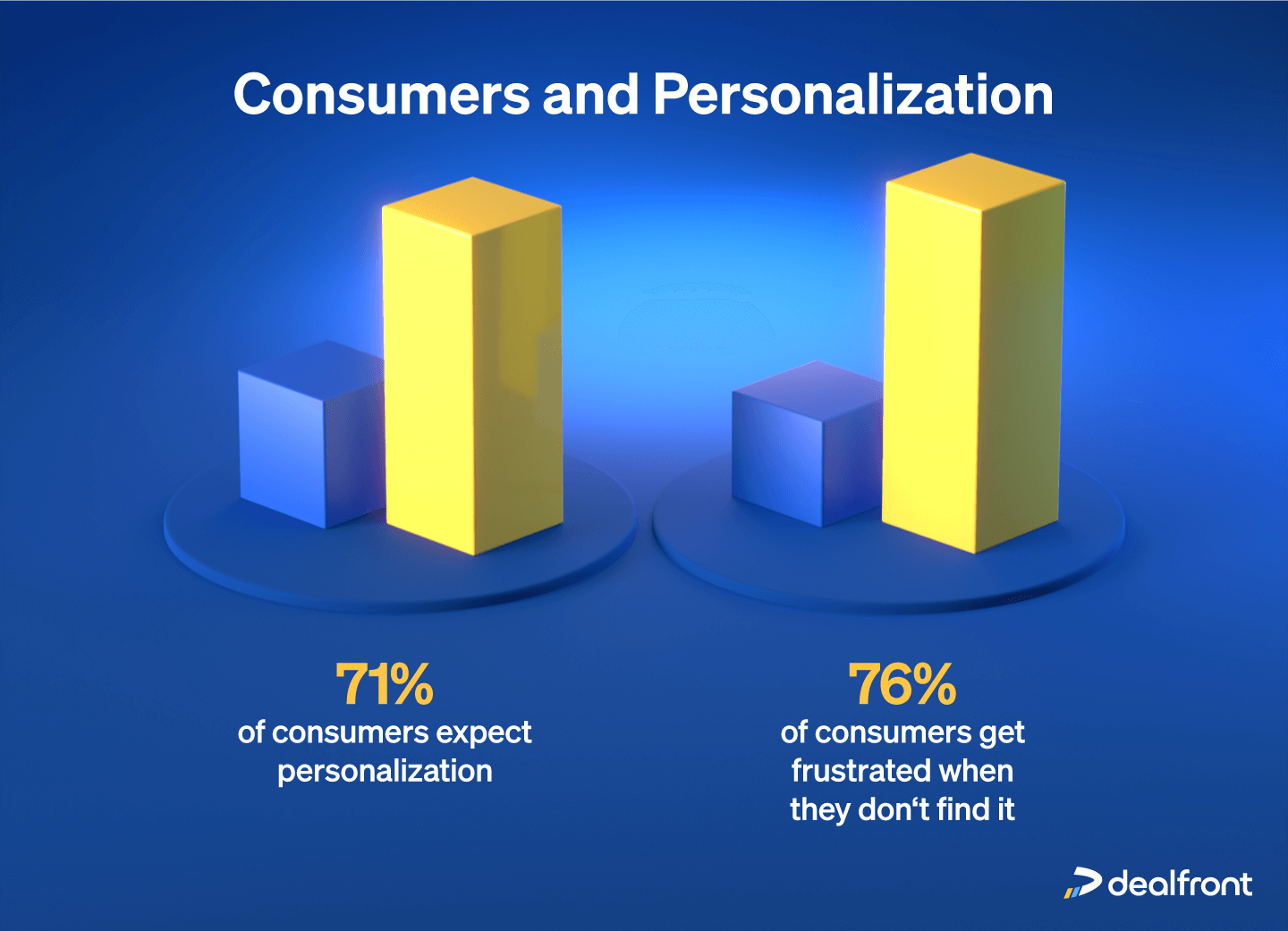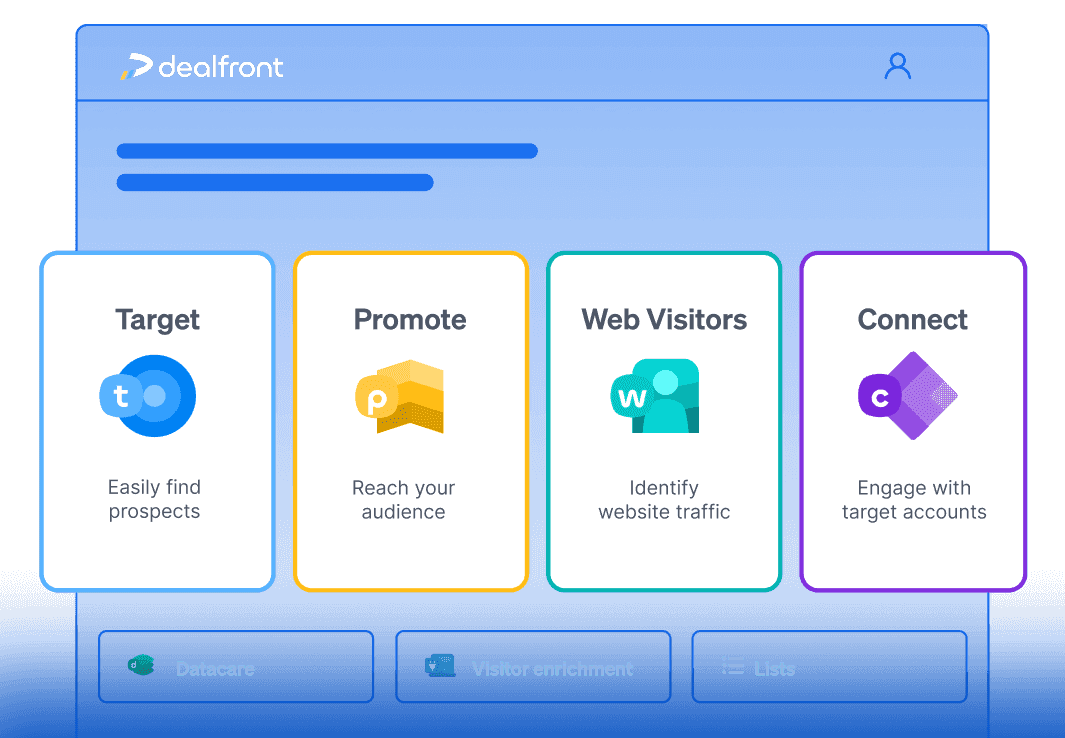In the dynamic world of B2B, it’s easy to lose sight of the fact that behind every business transaction, there’s an actual person. Companies keep using generic strategies and then wonder why they keep missing the mark with potential customers.
To remedy this, many businesses have turned to account-based marketing (ABM). This strategy has seen a steady rise in popularity because it helps you stand out in the sea of B2B sameness. How? With personalized content that’s tailored to your ideal customer profile (ICP) and further down the line, the decision-maker.
Today, you’ll learn:
What account-based marketing is
The benefits for you and your customers
How to reach the right decision-makers
We’ll also cover how to personalize and target your B2B marketing, sales and marketing alignment, the potential challenges of ABM, and how to solve them.
What is account-based marketing?
ABM is a strategic approach where businesses focus on building personalized connections with individual target customers rather than broad audiences. It involves crafting tailored messages, content, and solutions that resonate with each potential customer’s unique needs and pain points.
ABM requires close alignment between your sales and marketing teams to ensure a personalized and consistent experience for your leads and customers. By concentrating your efforts on key high-value accounts, ABM enhances customer relationships, improves engagement, and drives better business outcomes. It's about quality over quantity, offering a more precise way to engage and convert potential clients.
How to personalize and target your B2B marketing
To maximize the effectiveness of your account-based marketing strategy, tailor it specifically to your business, customers, and objectives.
Why you should target high-value accounts
If you want to elevate the effectiveness and success of your sales team’s efforts, targeting high-value accounts is the way forward. Instead of casting a wide net and hoping for a catch, focusing your efforts on high-value accounts offers many benefits.
High-value accounts are more likely to make substantial purchases and engage in repeat business. Nurturing the right accounts means investing in relationships that have the potential to be long-term. A focused approach allows for deeper personalization and tailored engagement. Each high-value account is unique, with distinct pain points, needs, and preferences. When you personalize your messaging, solutions, and interactions this will resonate more with your customers. The result? Higher customer satisfaction and an increase in the likelihood of conversions.

High-value accounts tend to be businesses that are already well-regarded in their industry. Strategically targeting them will enhance your own brand when these customers recommend you via testimonials, case studies or word-of-mouth. All this can lead to more high-value clients seeking you out as a trusted and proven provider. When focusing on high-value accounts, you can foster tighter alignment between your sales and marketing teams. They have to collaborate closely to tailor their messaging and strategies to cater to the unique needs of each account. You’ll see more effective communication and both teams working towards common objectives. Your business wins because this results in smoother conversions and a more cohesive customer journey. Well go into more detail about this alignment later on!
Understanding your target account’s pain points
Grasping your target audience's pain points is a key factor in succeeding with account-based marketing. By digging deeply into your target's pain points, you get a better understanding of their particular needs and objectives. This forms the basis for your ABM marketing campaigns. A one-size-fits-all approach doesn't cut it in the B2B landscape. So, having a strategy based on understanding pain points can make a real impact.
ABM prompts you to go beyond surface-level knowledge and explore the complexities of each target's issues. This means researching industry trends, company goals, and potential roadblocks. By uncovering pain points that might not immediately be obvious, you position yourself as a valuable ally who truly understands your prospect’s situation.
This strategic alignment between what you offer and your target audience’s pain points builds trust and credibility. It shows that you've invested the effort to comprehend their distinct needs and can provide solutions that genuinely help. As a result, your engagement becomes less about making a sale and more about forming a partnership built on shared goals.
Steps you can take to better understand your target audience include:
Research: Conduct thorough market research and develop an ideal customer profile (ICP) to delve beyond surface-level demographic data. This will help you tailor your ABM strategy with precision.
Social listening: Monitor social media platforms and industry forums on which your target accounts might discuss their pain points. This can give you real-time insights.
Data collection: Use data enrichment tools and gather information about your target accounts. This includes company size, industry, job roles, and recent news.
Interviews and surveys: Reach out to your existing clients and target accounts for interviews or surveys. Ask open-ended questions to understand their challenges, needs, and priorities.
Industry event participation: Attend webinars, conferences, and industry events that are relevant to your target accounts. Engaging in these spaces allows you to listen directly to their pain points.
Create a better overall customer experience
Research from McKinsey shows that 71% of consumers “expect companies to deliver personalized interactions,” and 76% “get frustrated when this doesn’t happen.” So personalized interactions help you not only target high-value accounts but also deliver a better customer experience.

ABM's personalized approach extends to every touchpoint of the customer journey. From the very first interaction, whether it's a tailored email or a personalized ad, your customers feel seen and understood. As the relationship progresses, your communication remains valuable, solidifying the sense that you're not just a vendor but also a trusted partner.
Additionally, because ABM fosters alignment between sales and marketing teams, customers receive consistent messaging and a unified approach. This minimizes confusion and maximizes clarity.
Account-based marketing also makes it easy for your customers to continue doing business with you.Regular check-ins and solutions that are designed to address evolving needs all contribute to a sense of genuine concern. This continuous attention translates into customer loyalty and, often, referrals within their networks.
Action steps you can take to create a better customer experience include:
Seamless handoffs: Ensure a seamless transition between your sales and customer support teams. Share insights gathered during the sales process to avoid repetition and create a smoother customer journey.
Persona development: Develop detailed buyer personas for each target account. These personas should include pain points, motives, preferences, and communication styles that are specific to each account.
Personalized content: Craft content that directly speaks to the pain points and needs of each target account and offers solutions.
Tailored interactions: Customize your communication for each account. Whether it's through emails, calls, or meetings, show that you understand their unique situation and are committed to solving their challenges.
Multichannel engagement: Engage your target accounts across multiple channels, including social media, email, webinars, and personalized landing pages.
Sales and marketing alignment
For many B2B companies, getting marketing and sales to work together smoothly is a roadblock. Let’s explore how ABM can help with this.
Fostering cross-team collaboration
Research from Forrester Consulting and RollWorks shows that 56% of small and midsize businesses see “tighter alignment between marketing and sales activity” with an ABM approach.
ABM acts as a common language between marketing and sales, fostering open conversations and shared goals. This shared focus drives the teams to work closely together, breaking down silos that might have hindered communication before.
ABM's core principle of personalization acts as the bridge between marketing and sales. When both teams understand the nuances of the client's pain points and needs, they can collaborate more effectively to provide tailored solutions. This ABM-driven teamwork not only enhances the customer experience but also fuels conversions and shortens sales cycles.
Additionally, ABM helps your sales and marketing departments work closely with your SEO and content marketing teams to organically attract qualified leads via search engines and social media (e.g. LinkedIn for B2B). This synergy not only boosts visibility but also increases the conversion rate by ensuring that the content resonates with the right audience.
Improving lead quality together
Historically, the divide between sales and marketing has led to friction and misalignment. Marketing would generate leads that the sales team may find to be unqualified or irrelevant, causing frustration. By instead working together from the outset in an ABM context, they can jointly identify high-potential accounts, ensuring that they concentrate on the right leads.
With ABM, both the sales team and the marketing team understand each lead’s unique pain points and needs. As a result, the interactions with potential customers become more meaningful and relevant. Instead of generic pitches, the sales team engages with insights that matter, showcasing a deep understanding of the lead's challenges and aspirations.
Our tip: Consult both sales and marketing to define your key performance indicators (KPIs). Traditional marketing often focuses on metrics like lead quantity and website traffic, while ABM focuses on metrics like account engagement and revenue from particular accounts. As part of the ABM collaboration, have the sales team assist with your marketing efforts in pinpointing the right KPIs. Regularly report on your ABM KPIs to maintain transparency.
What are the benefits of ABM?
With its many benefits, it’s not surprising that ABM is on the rise so let’s look at four of them.
1. Improved ROI and revenue generation
With ABM, you concentrate on a smaller set of accounts that hold the strongest potential to become clients. Through this heightened focus, you’re more likely to see successful outcomes.
Your sales and marketing teams collaborate to target these individual accounts in the most impactful way. They channel their resources and ensure that the right messages reach the right potential clients.
When evaluating your ABM performance, you should pinpoint and reinforce the most effective strategies. The narrow campaign makes it easier to gauge insights. You can discern which approaches gain traction and identify attempts that fall short.
2. Increased customer retention and loyalty
When a customer considers buying a new product or service, how do you ensure they consider buying from you rather than another company? In this scenario, your company can engage the customer with different initiatives like sharing success stories and potential solutions for their challenges. This approach guides the customer toward making a purchase decision, relying on your existing relationship to persuade them.
ABM strengthens your competitive edge, leveraging existing relationships for account growth and maintaining an advantageous position among competitors and suppliers.
By focusing on high-value accounts and cultivating stronger relationships, ABM can steer businesses toward revenue growth and an increased lifetime value for their customers.
3. Enhanced marketing efficiency
ABM turns the typical marketing and sales funnel upside down by starting with your best-fit prospects. Unlike the traditional marketing funnel, where you gather many prospects at the top, ABM uses precise targeting from the beginning to avoid unqualified leads. It's a focused, efficient method for capturing specific accounts.
Another upside is that you can focus not only on certain companies but also the key decision-makers at those companies. This increases the odds that the relevant people have the necessary information and can support purchasing your goods or services.
4. Stronger brand positioning
Through ABM programs, brands demonstrate a profound understanding of their clients' challenges and aspirations, fostering a sense of trust and credibility. This, in turn, elevates the brand’s reputation within the industry. As ABM nurtures long-term relationships and customer loyalty, satisfied clients become brand advocates, sharing their positive experience and expanding the brand's reach organically.
By showcasing the brand's commitment to individual client success, ABM bolsters your market positioning as a partner who’s invested in customer growth. This tailored, customer-centric marketing approach enhances your differentiation, solidifies your brand identity, and empowers your brand to stand out as a valuable resource within a competitive landscape.
What are some of ABM’s potential challenges?
ABM has emerged as a powerful strategy for B2B companies, but like any approach, it comes with its own set of challenges. To succeed with your ABM efforts, it’s crucial to understand these challenges and have effective solutions in place.
1. Resource limitations
ABM often demands more focused efforts and personalized interactions, which can strain your resources. Businesses may struggle to allocate sufficient time and manpower to tailor campaigns for each target account, especially new companies or those launching a new product as part of their go-to-market strategy.
Solution: Prioritizing and segmenting
Segment your accounts into tiers based on their potential value. Allocate your resources strategically, focusing intensely on high-priority accounts while implementing more automated processes for lower-tier accounts. This segmentation ensures that you invest your resources where they have the biggest impact.
2. Data quality and availability
ABM thrives on accurate, up-to-date data, yet many businesses struggle with maintaining a reliable database, hindering their personalization efforts.
Solution: Data hygiene and enrichment
Regularly clean and update your data to maintain its accuracy. Use a tool like Dealfront Connect, which supports companies by properly prioritizing their prospects and providing insights into when they should reach out to each one. It has B2B data on more than 30 million companies from trade registries, company websites, news articles, and social media. In combination with Dealfront's Datacare, which helps businesses check, cleanse, enrich, and optimize their data, sales databases, and CRM systems, your data will stay as up-to-date as possible.
3. Sales and marketing alignment
Close collaboration between your salesforce and marketing is crucial in ABM, but differing priorities and communication gaps can create friction between these teams. This is a perennial challenge, no matter what type of marketing you use, but it’s critical to solve it if you’re using ABM.
Solution: Cross-functional teams and clear communication
Form cross-functional teams composed of both sales and marketing stakeholders. Regularly scheduled meetings and clear communication channels ensure that both teams are on the same page while working toward common objectives.
4. Scalability
ABM focuses on personalized interactions, but scaling your efforts to reach a larger number of accounts without sacrificing personalization can be a challenge.
Solution: Technology and automation
Use a marketing automation platform to streamline your processes while maintaining personalization. Use templates and predefined workflows to ensure consistent messaging across different accounts. Automation can help you maintain your efficiency as you scale your ABM efforts.
5. Measurement and ROI
Measuring the success of ABM campaigns and demonstrating the return on investment can be complex due to the highly personalized nature of the interactions.
Solution: Clear metrics and attribution models
Define specific KPIs for each tier of key accounts. Establish clear attribution models that track the impact of your ABM efforts at each stage of the customer journey. This data-driven approach allows you to measure a higher ROI more accurately.
Is account-based marketing what your business needs?
No one knows your company better than you. Ultimately, the case for ABM depends on your sales and marketing teams’ needs. But ABM offers substantial benefits, such as improving your lead generation in general, lead quality, increasing your ROI, and improving your customer retention. Through ABM, you can drive more personalized, impactful, and fruitful B2B engagements.







